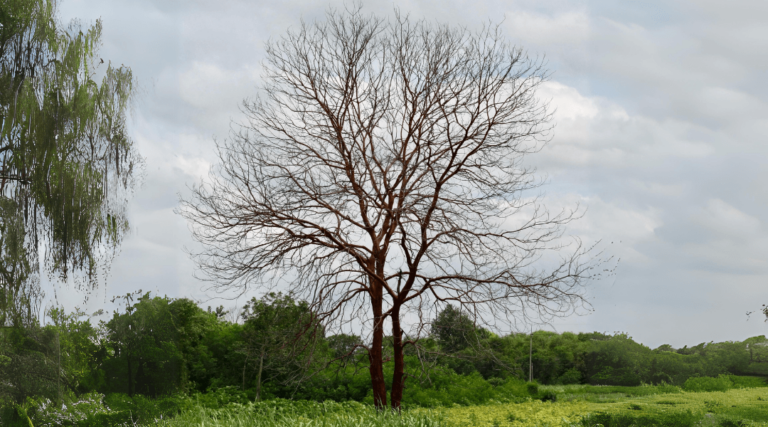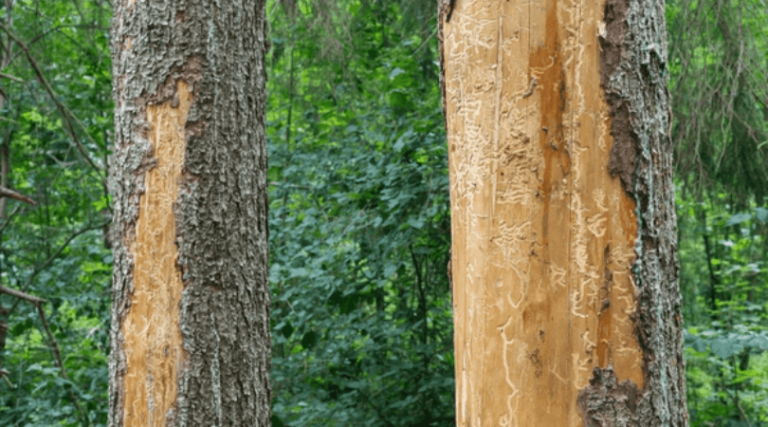
TOP 6 SIGNS that shows your Tree Sick OR Dying?
Have you ever felt sad watching the plant you planted slowly die, not knowing why? It’s always heartbreaking to see a plant we’ve cared for and nurtured start to get sick, and often we don’t realize it until it’s too late. There could be many reasons, but we still don’t understand the main factors. Here are six signs your tree might be in trouble. It’s important to take care of trees when you see those signs.
1. Leaf Discoloration and Abnormalities:
One of the earliest indicators of a sick or dying tree is changes in its foliage. Keep a close eye on the color and condition of the leaves. If you notice unusual discoloration, such as yellowing, browning, or blotchy patterns, it may signal nutrient deficiencies, pest infestations, or diseases. Additionally, the presence of abnormal growths, spots, or deformities on the leaves can be indicative of underlying issues.
Regularly inspect your tree’s leaves throughout the seasons, as certain diseases or pests may manifest differently depending on the time of year. If you observe persistent discoloration or abnormalities, it is advisable to consult with professionals offering tree installation services to assess and address the problem promptly.

2. Bark Irregularities:
The bark of a tree serves as its protective outer layer, and any abnormalities in its appearance may indicate health issues. Peeling or cracking bark, along with the presence of cankers (sunken lesions), may suggest disease or infestation. Additionally, the emergence of fungi or lichen on the bark could be a sign of decay, which may compromise the structural integrity of the tree.
Regularly inspect the trunk and branches for any changes in bark texture, color, or the presence of unusual growth. A professional tree installation service provider can conduct a thorough examination and recommend appropriate measures to address these bark irregularities.
3. Unusual Growth Patterns:
Healthy trees exhibit predictable growth patterns, but abnormalities such as stunted growth, excessive leaning, or erratic branching can be signs of underlying issues. Trees respond to stress by adjusting their growth, and these deviations may indicate problems such as root damage, soil compaction, or structural weaknesses.
An arborist or tree care professional specializing in tree installation services can assess the growth patterns of your tree and identify the potential causes of these irregularities. Addressing the underlying issues promptly can help mitigate further damage and improve the tree’s overall health.
4. Lack of New Growth:
A healthy tree continually produces new growth, whether in the form of leaves, branches, or buds. If you observe a lack of new growth or notice that the tree is not producing leaves during the expected season, it may be a cause for concern. This could be due to factors such as nutrient deficiencies, environmental stress, or root system problems.
Regularly monitor your tree for signs of new growth, especially during the spring and early summer. If you notice a lack of vitality and growth, consulting with a tree installation service provider can help identify and address the root causes of the issue.

5. Decay and Holes:
Visible signs of decay, such as soft or crumbly wood, along with the presence of holes or cavities in the trunk, can indicate serious internal problems. Decay may result from various factors, including fungal infections, insect infestations, or physical injuries. Insects like wood-boring beetles or termites can compromise the structural integrity of a tree by creating extensive tunnels within the wood.
Regularly inspect your tree for any visible signs of decay or holes. If you suspect internal issues, it is crucial to seek the expertise of professionals offering tree installation services. They can employ advanced diagnostic techniques, such as tree tomography, to assess the internal health of the tree and recommend appropriate treatments.
6. Root Issues:
A tree’s root system plays a vital role in its overall health and stability. Issues such as root rot, girdling roots, or compacted soil can significantly impact the tree’s well-being. Symptoms of root problems may include wilting foliage, dieback, or a general decline in the tree’s overall health.
If you notice signs of root issues, it is essential to consult with arborists or tree installation service experts who can conduct a comprehensive root inspection. Addressing root problems promptly is crucial for the long-term health and stability of the tree.
Caring for Sick or Dying Trees-
Recognizing the signs of a sick or dying tree is the first step towards preserving its health, but equally important is implementing effective care strategies. Here are essential steps to take when faced with a tree in distress:
- Professional Consultation: Engage the services of a certified arborist or a tree installation professional to conduct a thorough assessment of the tree’s condition. Their expertise enables them to diagnose the specific issues affecting the tree and formulate a targeted treatment plan.
- Soil Analysis and Nutrient Management: Conduct a soil analysis to identify nutrient deficiencies and imbalances. Based on the results, implement a tailored fertilization program to provide the necessary nutrients for the tree’s recovery. Adequate nutrition strengthens the tree’s immune system and promotes overall well-being.
- Pruning and Trimming: Remove dead, diseased, or damaged branches through proper pruning and trimming techniques. This not only improves the tree’s appearance but also enhances air circulation, reducing the risk of fungal infections. Additionally, selective pruning redirects the tree’s energy towards healthier growth.
- Watering Practices: Assess the tree’s water needs and ensure a consistent watering schedule, particularly during periods of drought or excessive heat. Proper watering helps alleviate stress on the tree and supports root health. Be mindful of overwatering, as waterlogged soil can lead to root rot.
- Pest and Disease Management: Implement targeted pest control measures if infestations are identified. This may involve the use of insecticides or biological controls to mitigate the impact of harmful pests. For diseases, appropriate fungicides or bactericides can be applied based on the arborist’s recommendations.
- Mulching: Apply a layer of organic mulch around the tree, leaving space around the trunk to prevent moisture-related issues. Mulching helps retain soil moisture, regulates temperature, and inhibits weed growth. It also contributes to soil structure and fertility.
- Support Systems: Install support systems such as braces or cables for trees with structural weaknesses. This helps prevent further damage during storms or adverse weather conditions, allowing the tree to recover without additional stress.
- Regular Monitoring: Continue to monitor the tree’s progress regularly. Adjust care strategies as needed based on the tree’s response and any changes in environmental conditions.
Conclusion:
Trees are living organisms that require proper care and attention to thrive. By staying vigilant and recognizing the early signs of a sick or dying tree, you can take proactive measures to address issues before they escalate. Professional tree installation services play a crucial role in maintaining the health and beauty of your trees, offering expert guidance and interventions when needed. Regular tree inspections, timely treatments, and appropriate care can contribute to the longevity and well-being of your valuable green companions.
